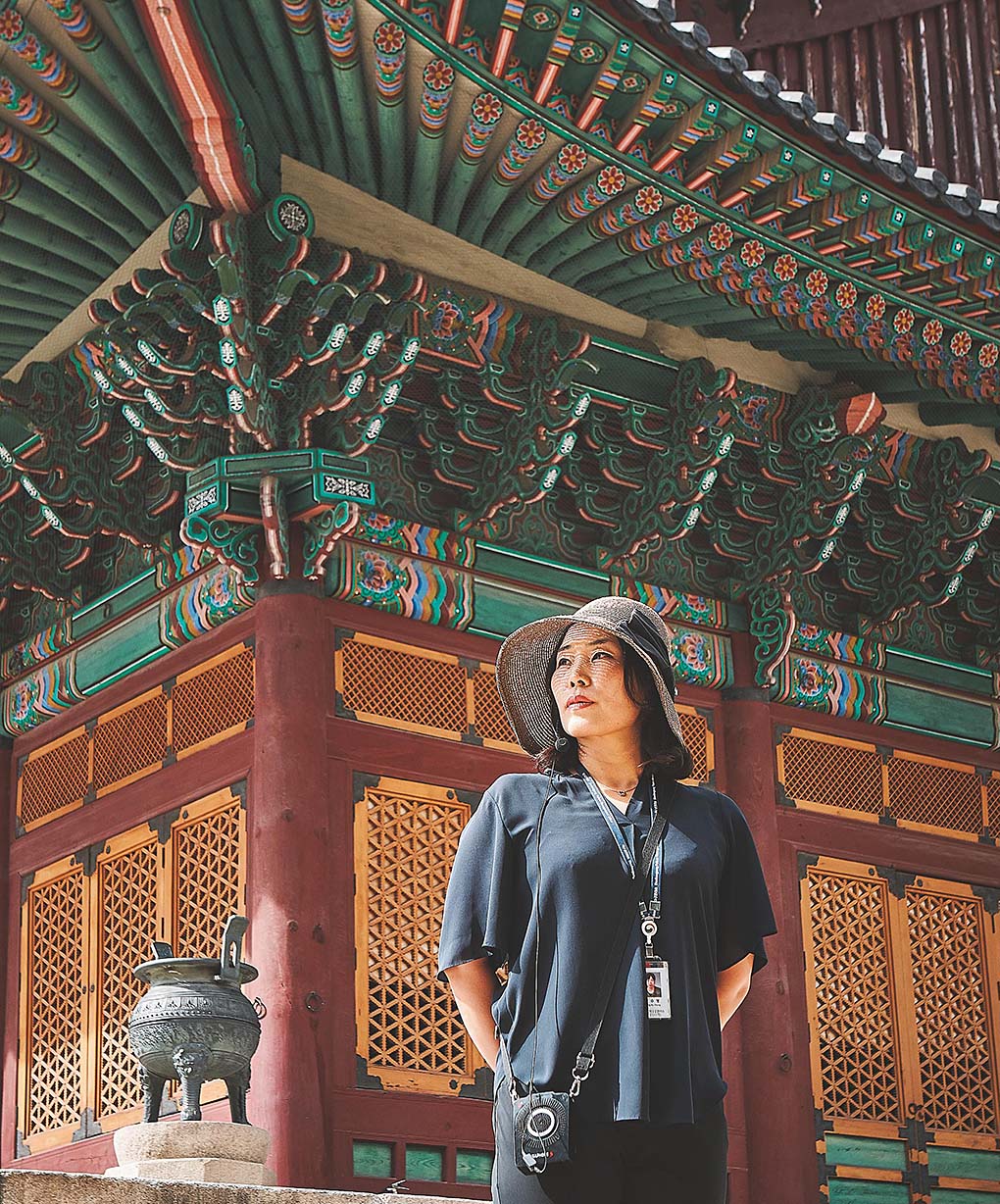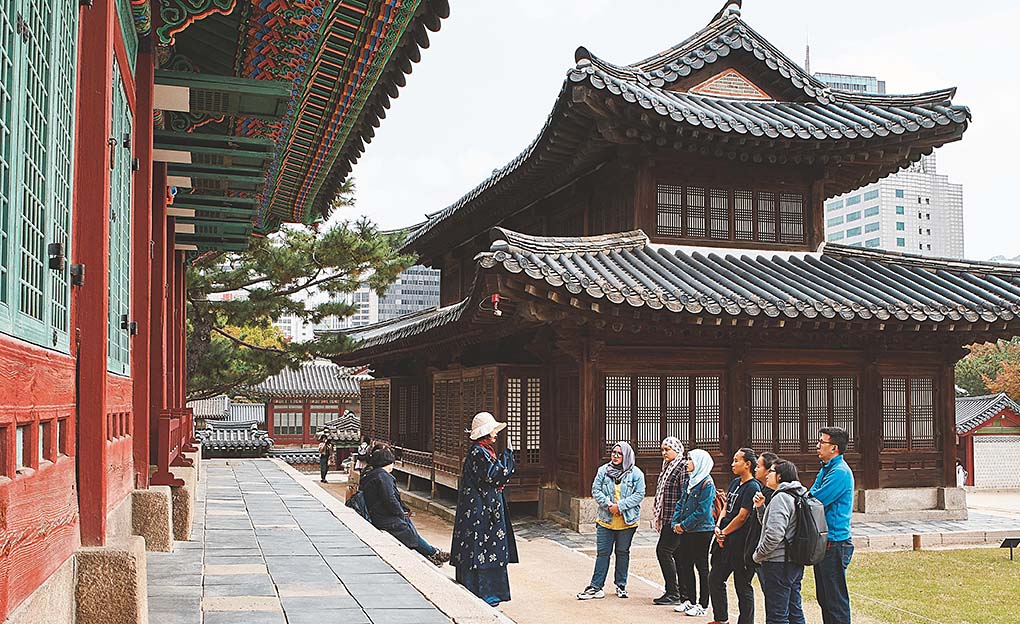It is natural to feel a sense of satisfaction after helping a tourist with directions on the street. Some people have that warm feeling every day. Palace guide Chang Su-young is one of them.

Chang Su-young stands outside Junghwajeon (Hall of Central Harmony, Treasure No. 819), the throne hall of Deoksu Palace. Although she has only been a palace guide for two years, Chang says she feels greater responsibility with each passing day.
“I went to Mt. Jiri for the first time when I was in university, and I loved the mountain so much that I often returned there. Sometimes I would go for just two days. Other times I would spend a whole week leisurely hiking from one end to the other. Standing at the highest peak looking down at a sea of clouds below, it occurred to me that all the things down in the city that had made me anxious and my head ache were really not so important. Mt. Jiri is a place of rest for me, so I still go there often.”
Chang Su-young was born in Busan, but the port city did not translate into a love of beaches and the sea. She preferred the mountains. Nearly every notable mountain in South Korea has felt her footsteps. The 1,915-meter high Mt. Jiri is the second-highest mountain after Jeju Island’s Mt. Halla in South Korea, and it brought not only calm. Its trails led Chang to a career-changing decision.
“Walking along a mountain path, I can feel a kind of strength, so vast I can’t tell where it begins or ends, and I also find myself wondering about all the people the mountain has sheltered,” Chang says. “People call Mt. Jiri the ‘mother mountain,’ not only because it has a cozy, embracing feeling, but because partisans hid in its valleys and folds during the Korean War. Even now, people who are suffering or exhausted by life go to this mountain to live out the rest of their lives there. My love for Mt. Jiri grew to encompass all the traces of the people who have made it their home. And that got me thinking about the traces of our ancestors, those who have lived here and there around this land and are now gone. I started wishing that I could share their stories with others.”
Chang studied English language and literature at Silla University in Busan, and after graduating she taught English at schools and cram institutes for over 10 years. However, the more time she spent in the mountains, the more interested she became in Korean history and culture, and in June 2017 she became an official tour guide at Deoksu Palace, in the heart of Seoul.
Storied History
Deoksu Palace (meaning the “Palace of Virtue and Longevity”) was among the five royal palaces of the Joseon Dynasty (1392–1910). All eight of the palace’s guides are fluent in at least one foreign language. Four guides lead in English, two in Japanese and two in Chinese. They each give two or three free tours per day, lasting around 50 minutes each.
“Deoksu Palace is smaller than most of the other palaces and it gets fewer visitors. But it holds more history than any other palace, so you need to know the entire flow of Korean history in order to really tell its story,” says Chang.
“Notably, the palace was the site for so many historical events relating to Japan, so the tour guides study the historical relationship between Korea and Japan extensively,” she says. “These days, as well as knowledge of all the history, I feel that it’s really important to know how to convey it effectively. There are so many nuances and sensitive areas in history, so you have to take care with each and every phrase you use, making sure not toany misunderstanding.”
Initially, Deoksu Palace was not of much consequence. It was simply the home of Prince Wolsan, the older brother of King Seongjong (r. 1469–1494). But wars brought it into history books.
During the Japanese invasions in the 1590s, all of the royal palaces within the walls of Hanyang (largely the old city center of present-day Seoul) were burned. The prince’s old home where his descendents lived, however, remained fairly intact. It became the temporary palace of King Seonjo (r. 1567–1608) when he returned to the capital. After his son, Prince Gwanghae (r. 1608–1623), ascended to the throne, the new king moved to Changdeok Palace which had been rebuilt. Seonjo continued to live at the temporary palace, which was named Gyeongun Palace.
In 1896, King Gojong moved into Gyeongun Palace after taking refuge at the Russian Legation when foreign powers pressured Korea. The next year, he proclaimed a new state, called the Korean Empire. He also changed his title from king to emperor, but he only ruled until 1907, when he abdicated in favor of his son, Sunjong, under Japan’s pressure. The new emperor moved to Changdeok Palace, but Gojong remained at Gyeongun Palace, which was renamed Deoksu Palace. From there he watched the fall of the Korean Empire and the beginning ofJapanese rule in 1910.
Chang has discovered that her tour groups have more than a casual interest in the palace. That aligns with what her senior cohorts say: “The visitors coming to Deoksu Palace now are not the same as before.”
“These days there are many foreign tourists
visiting this palace with a deep interest in learning
more about Korea’s history and culture,
and some of them already know a great deal.”

Clad in a navy durumagi coat over a white blouse and navy skirt, Chang Su-young explains the history and architecture of palace halls to a tour group. Aside from the hottest days of summer, the palace guides wear a hanbok year round.
Eclectic Mix of Tourists
“These days there are many foreign tourists visiting this palace with a deep interest in learning more about Korea’s history and culture, and some of them already know a great deal,” says Chang. This is credited to Korea’s cultural exports such as K-pop, movies and TV series, which have sparked interest in the country.
“There are even visitors who ask detailed questions, like ‘Why did Gojong have to change his title to emperor when king and emperor both stood for the highest power?’ In such cases, I explain that Gojong changed the name of the country and his title in order to defend Korea’s national sovereignty against the world powers, including Japan, by proclaiming it an autonomous nation.”
Chang also detects differences in her interaction with tourists, depending on their nationality. “The way German visitors engage with the tour is particularly memorable for me. They pay attention to every single word and listen as though they’re conducting research. They ask the most questions, too. I have also seen people tear up while listening to the tumultuous stories of this palace.”In general, the shorter the history of the country the visitor is from, the more interest they show in historical details, Chang says. “Is there still a royal family in Korea?” is among the most frequent questions she is asked.
Since much of the palace’s history is linked to Korean-Japanese relations, visitors also ask about the current state of affairs. “I tell them that, although official relations between governments can get strained, there is always a lot of interaction between the people of both countries. The guides who give tours in Japanese are more sensitive to the relationship between Japan and Korea, and they get many more questions like that.”
Never-ending Study
Deoksu Palace is noted for its eclectic mix of buildings, which means its guides must be well-versed in the architecture as well as the history of the palace.
“The buildings themselves are the sites of history, so you can’t really bring up history without talking about architecture,” Chang says. “Foreign visitors listen intently when I talk about the palace buildings such as Junghwajeon, Jeukjodang and Hamnyeongjeon, which were destroyed in the great fire of 1904 and rebuilt anew. Some people ask me, all amazed, ‘How was it possible to rebuild such amazing structures in such a short time?’ And unlike any of the other palaces, Deoksu Palace also has modern Western-style buildings, so I need to have proper knowledge of that kind of architecture, too.” Traditional Korean and Western-style buildings dot the grounds of this palace. One of the most notable Western-style buildings is Seokjojeon, or the Pavilion of Stone. Completed just months before Japan’s annexation of Korea after a 10-year construction period, the neo-classical hall was mainly used to receive foreign dignitaries.Chang’s daily routine gives her great joy. The hope that foreign visitors will understand the heritage of Deoksu Palace a little better thanks to her explanations means that every day matters. Each morning, without fail, she leaves home at 7:50 to ride the circular No. 2 subway line and arrive at Deoksu Palace by 8:30 to prepare for her 9-to-6 work day.
The standard work garb is a hanbok, which Chang regards as another way to convey Korean culture. It is the traditional Korean dress mostly worn for festivals, ceremonies and celebrations nowadays. In spring and autumn, Chang dons a white jeogori (short jacket) and navy chima (long skirt); in summer, a beige or sky blue jeogori with a navy blue or purple-tinged navy skirt; and in winter, she has a long durumagi (overcoat) to put over the whole ensemble. There are exceptions, of course. During heat waves the guides slip into short-sleeved blouses and lightweight pants, and when the temperature plummets they put on long padded coats.
Stamina Needed, Too
Unlike everyone else, Chang’s day off is Monday, when palaces in Seoul are closed. Three days a week she goes to a health club for yoga and Pilates after work, and on Wednesday evenings she takes piano lessons.
“Before I became a palace guide, I was ready to go and live at Mt. Jiri, up in the mountains. But now I feel like there is lots of work for me to do here at this palace,” Chang says. “I want to become an even better guide than I am now, and there are so many ways I can use my energy to achieve that. First and foremost, palace guides need to have a real love for Korea and Korean culture. And then, we need to be able to communicate as well as possible in our second language, and since we carry on with our tours even in rain and snow, we need to be fit and healthy. That’s why I make time to exercise.
“But the most important thing, in my opinion, is for a guide to approach the visitors with an open heart. These days, I’m reading all Korean history books that are available in English. When I finish giving a tour, I hope to hear things like, ‘The tour was informative. After hearing your explanation, I want to come back to Korea and visit this palace again.’”
Chang still vividly remembers her first tour.
“I gave a guided tour for just one visitor. She was a university student from Chile, and she was very kind. When I told her, ‘You’re the first person I’m showing around this palace, it’s an honor for me to give you this guided tour,’ she said that it was an honor for her, too. When I asked her to tell me which famous places I should visit if I ever got the chance to go to Chile, she wrote a whole list for me.”
She never got to learn her name, but Chang hopes the Chilean student will revisit Deoksu Palace someday. She is sure she can give her a better tour than last time.